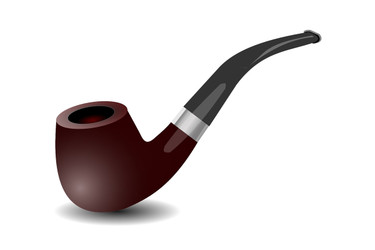Carpets get waterlogged, lawns get waterlogged and work boots can get waterlogged. But tobacco pipes? Can they really get waterlogged? And what on earth would cause a pipe to get waterlogged, besides putting it into the dishwasher by mistake or a flood that inundated your house?
Here’s the thing; when pipe smokers talk about their pipe being waterlogged they’re not talking about waterlogged in the conventional sense. So dishwashers and floods are not the culprits here. No, when pipe smokers talk about waterlogged pipes they’re talking about moisture damage often caused by improper smoking technique. Below, we’ll get into it in more detail.
How do Tobacco Pipes Become Waterlogged?
As tobacco burns one of the byproducts of the combustion process is condensation. Since there are no drainage canals inside the pipe this moisture must be given the chance to evaporate naturally, otherwise it may accumulate inside and cause problems. In some cases excessive saliva may add to the moisture level inside the pipe, but saliva alone is almost never to blame for a waterlogged pipe.
So how come all tobacco pipes don't get waterlogged? The reason some pipes get waterlogged and others don't is usually a matter of bad technique vs good technique. In particular, if a person employs an uneven or sporadic rhythm to their pipe smoking, or they draw infrequently but intensely on the pipe, moisture can get trapped inside causing the pipe to become waterlogged.
Improper smoking technique can sometimes result in the formation of a crust inside the curved shape of the pipe that forces the smoke to take an unnatural route around it, bringing an excessive amount of moisture into contact with one area, eventually leading to waterlogging.
It should be noted too that temperature changes inside the stove can sometimes result in a pipe becoming waterlogged. These temperature variations can be the result of packing the bowl too tight or too loose, or not cleaning the pipe regularly.
How to Tell if Your Pipe is Waterlogged
One of the primary symptoms of waterlogging is reduced flavor. This happens because excess moisture backs up into the bowl dampening the tobacco and causing it to burn inefficiently.
What Can Be Done About Waterlogged Pipes?
There are several things you can do to prevent or address waterlogging.
- Choose your tobacco carefully. If you choose one that is excessively moist you may invite waterlogging.
- Clean your wooden pipe regularly to remove excess moisture and to ensure the airflow is always smooth and unobstructed.
- If you believe condensation has formed in the stove or stem let the pipe rest for 24 - 48 hours before using it again.
- If you are smoking a particularly moist tobacco insert a pipe cleaner into the pipe after you smoke and leave it there for several hours to absorb any moisture.
- Never smoke several bowls of tobacco in rapid succession.
- Always store your tobacco pipes in a cool, dry place.
The more condensation inside the pipe the longer the pipe should be allowed to rest. Failing to address waterlogging will result in increasingly drab, unpleasant and eventually, harsh and bitter smokes.
Paykoc Pipes: A Full Line of World-Class Tobacco Pipes & Tobacco Pipe Accessories
Waterlogging is a vexing issue that can ruin your pipe smoking experience if not identified and handled properly. Take the above information to heart and you should be able to bring any waterlogged pipe back from the brink.
And for a complete line of world-class briar and meerschaum pipes, wholesale tobacco pipes and pipe accessories shop the Paykoc Pipes online store, or visit our brick-and-mortar shop on Logan Court in central Denver. We're here seven days a week.

 US Dollars
US Dollars
